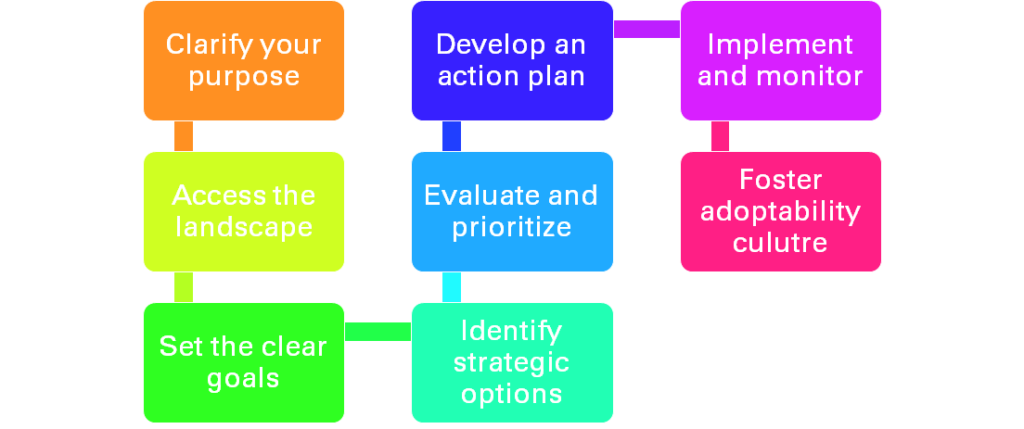In the pursuit of success, having a well-defined roadmap is crucial. Just as a traveler relies on a detailed map to reach their destination, organizations must develop a strategic roadmap to navigate the complexities of the business landscape. The strategic formulation is the process of charting this roadmap, setting the course for long-term success. In this blog post, we will explore the key steps involved in the strategic formulation, providing you with a comprehensive guide to creating your own roadmap to success.

Clarify Your Purpose
Every successful journey begins with a clear sense of purpose. Start by clarifying your organization’s why. What is the driving force behind your existence? What unique value do you bring to the table? By understanding your purpose, you can set a strong foundation for the strategic formulation, ensuring that every decision and action aligns with your core identity.
Assess the Landscape
Before embarking on any journey, it’s essential to understand the terrain. Conduct a thorough analysis of the external environment, including market trends, customer needs, and competitor activities. Additionally, assess your internal capabilities, strengths, and weaknesses. This analysis will provide valuable insights to inform your strategic decisions and help you identify opportunities and challenges that lie ahead.
Set the clear goals
A roadmap is meaningless without a clear destination in mind. Set specific, measurable, attainable, relevant, and time-bound (SMART) goals that align with your organizational vision. These goals will serve as guiding stars, providing direction and focus to your strategic formulation process. Ensure that each goal is well-defined and cascades down from your overarching vision.
Identify Strategic Options
Once you have your goals in place, it’s time to explore strategic options. Generate alternative approaches and scenarios that can help you achieve your objectives. Consider different paths, business models, market segments, and partnerships. Think creatively and expansively, allowing yourself to explore new possibilities beyond conventional norms.
Evaluate and Prioritize
Not all strategic options are equal. Evaluate each alternative based on various criteria such as feasibility, potential return on investment, competitive advantage, and alignment with your goals. Prioritize the options that have the highest potential for success and are best suited to your organization’s capabilities and resources. Remember, the strategic formulation is about making informed choices that will drive your organization forward.
Develop an action plan
With your strategic options and priorities identified, it’s time to develop a detailed action plan. Break down each strategic initiative into actionable steps, assigning responsibilities, timelines, and resources. Think of this as mapping out the milestones and waypoints on your journey. A well-structured action plan will provide clarity and accountability, ensuring that your strategic goals are translated into tangible actions.
Implement and Monitor
A roadmap is useless if you don’t follow it. Implement your action plan with diligence and commitment. Assign dedicated teams or individuals to execute each initiative. Monitor progress regularly, track key performance indicators, and evaluate the effectiveness of your strategies. Be prepared to make adjustments and course corrections as needed, keeping a close eye on market dynamics and feedback from stakeholders.
Foster a Culture of Adaptability
In today’s dynamic business landscape, adaptability is crucial for long-term success. Encourage a culture that embraces change and continuous improvement. Encourage feedback, promote innovation, and empower employees to contribute their ideas. Remember, a successful roadmap is not set in stone—it is flexible and responsive to evolving circumstances.
Conclusion
Creating a roadmap to success through strategic formulation is an essential endeavor for any organization. By clarifying your purpose, conducting a comprehensive analysis, setting clear goals, identifying strategic options, evaluating and prioritizing, developing an action plan, implementing and monitoring, and fostering a culture of adaptability, you can navigate the complexities of the business landscape with confidence.
Think of strategic formulation as the compass that guides your organization’s journey. Each step in the process brings you closer to your desired destination. As you embark on this transformative journey, remember that strategic formulation is not a one-time event but an ongoing process. Continuously reassess your strategies, adapt to changing circumstances, and refine your roadmap as needed.
Just as a well-planned roadmap provides clarity and direction to travelers, a strategic formulation roadmap empowers organizations to make informed decisions, seize opportunities, and overcome challenges. Embrace the process, involve key stakeholders, and foster a collaborative environment where ideas can flourish.
So, gather your team, ignite your strategic thinking, and embark on the journey of strategic formulation. With a well-crafted roadmap and a clear vision in sight, you are well on your way to achieving sustainable success and turning your organizational aspirations into reality.
Remember, success is not just about reaching the destination; it’s about the transformative journey you take along the way. Embrace the challenges, learn from experiences, and celebrate the milestones as you navigate the ever-changing business landscape.
Get ready to embark on your strategic formulation journey and unlock the potential for growth, innovation, and success. Your roadmap awaits—let the adventure begin!